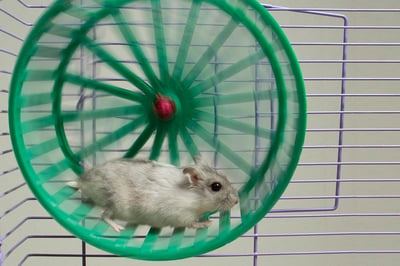Do you ever wonder why you’re so strongly motivated to exercise while it seems that some others inexplicably aren’t? The answer may lie in the differences between your gut microbiomes! Nature, the world’s leading multidisciplinary science journal, recently published the results of a study conducted in the laboratory of Christoph Thaiss at the University of Pennsylvania, where they seek to better understand how exercise-induced neurochemical changes in the brain lead to motivating pleasure in "jogaholics."

As a model of a diverse population, the researchers bred a cohort of 199 mice with random genetic backgrounds. When provided with the opportunity to exercise (i.e. running on a wheel), individual mice exhibited a wide variety in performance, with some choosing to run >25 km per day and others not running at all. To uncover the source of this variability, researchers thoroughly characterized each mouse (10,500 points of data per mouse!) including genome sequencing, blood work, and metabolic parameters including food, O2, and CO2 intake. None of these, nor any combination, correlated with exercise performance as well as gut microbiome composition.
To confirm the link, mice were depleted of intestinal bacteria using broad-spectrum antibiotics – this led to a 50% decrease in exercise performance, which fully recovered after cessation of treatment. Further, transplantation of microbiome samples led to a strong correlation between recipient and donor performance, i.e. transplants from more active individuals led to greater increases in performance!
Before you rush to your doctor to ask for a fecal transplant from your most athletic cousin, let’s explore how exactly bacteria in your gut can make your brain enjoy exercise. First, the authors of this study sought to identify which specific bacteria are most responsible for the effect. Rather than using broad-spectrum antibiotics, seven individual antibiotics were tested separately. For example, mice transplanted with microbiota samples from ampicillin-treated donors showed a significant decrease in performance, whereas recipients from neomycin-treated donors were unaffected. After identifying which bacterial species were sensitive to which antibiotics, each could be correlated with exercise performance. Indeed, the most correlated species, Eubacterium rectale and Coprococcus eutactus, enhanced performance when introduced into germ-free mice; and conversely species predicted not to correlate did not. The authors coin the phrase “exercise-enhancing bacteria” for these strains.
At the other end of this pathway is the brain. Dopamine level in a particular set of neurons (striatal medium spiny neurons) is a known regulator of the drive for physical activity. The researchers observed that certain antibiotic treatments temporarily “nearly eliminated” post-exercise dopamine release in the treated animals. Mirroring the effects on exercise performance described above, mice receiving microbiota transplants from high-performing mice showed increased post-exercise dopamine levels. The dopamine-degrading enzyme monoamine oxidase (you’ve probably heard of MAO inhibitors as treatment for depression) is typically suppressed during exercise, but this was not observed in antibiotic-treated mice! Indeed, treatment with a MAO inhibitor restored the exercise performance of antibiotic-treated mice.
The final link in this chain is the cells linking the gut to the central nervous system, called ‘gut-innervating afferent sensory neurons.' By analyzing metabolic breakdown products present in stool samples of mice treated with each of the antibiotics above and cross-referencing that with each sample’s ability to activate these sensory neurons, the authors were ultimately able to identify numerous fatty acid amides (FAAs) that are likely responsible for enhanced post-exercise dopamine in the brain of mice. When these FAAs are recognized by a receptor on the surface of the sensory neurons called CB1, the cells signal the brain to suppress MAO expression.
To summarize, these studies showed that in the mouse, certain bacteria in the gut microbiome produce certain fatty acid amides that stimulate afferent sensory neurons to signal the brain to suppress MAO expression upon exercising, which leads to enhanced dopamine signaling, interpreted as pleasure, ultimately motivating the individual to exercise more. Why would we have evolved like this? Undoubtedly the ability to engage in prolonged physical activity conferred a survival advantage at some point in history.
The authors of this article propose that nutrient availability to the individuals whom this fitness benefitted most coincidentally created intestinal environments favorable for exercise-enhancing bacteria. Could the waning of this fitness advantage in modern times have led to widespread changes in human microbiome compositions that feeds back into our increasingly sedentary lifestyle and the obesity epidemic? Research on this will almost certainly proceed. Additional work will also be needed to understand whether the specific bacteria and FAAs that showed benefit in mice will have a similar effect in humans. The most exciting takeaway may be new opportunities for supplements or probiotics with exercise-enhancing effects. Despite a $41 billion global market size, no products have yet shown this benefit, but clearly there is tremendous potential – not only for the general population, but also for individuals with PWS.








